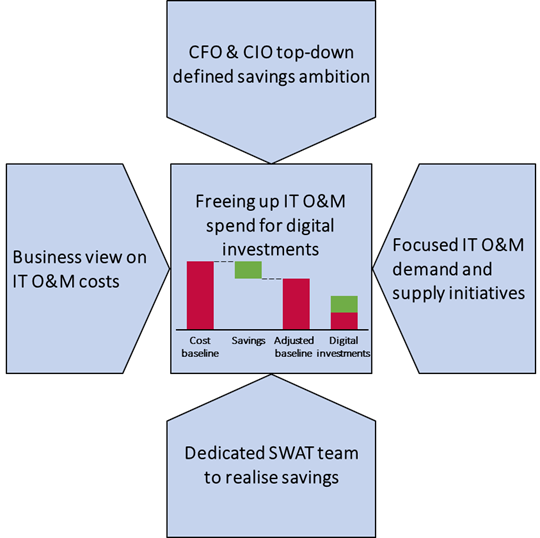As companies are experiencing a significant increase in the demand for digital solutions, they need to find ways to fund it. The CIO should contribute by facilitating an IT O&M cost reduction.
Digital Transformation Spend Has Gone Through the Roof and so Will IT Operations & Maintenance Spend
The need for digital services and solutions has exploded across industries. Executives are constantly receiving funding requests for new or improved digital solutions which surpass their digital/IT budgets. These solutions are perceived as critical to remain competitive and result in an increase in IT development spend.
For example, in retail the global IT spend is expected to grow by approximately 4% each year (CAGR) from 2021-2027. This increase is driven by, e.g., large investments into revamped online shops, AR & VR enabled in-store and online experiences, voice-assisted shopping, IoT enabled beaconing of consumers, consumer behaviour analytics, RPA enabled logistics, robot handled warehouse systems. All these solutions will subsequently need to be operated and maintained once fully implemented, thus also resulting in an increase in IT O&M spend.
Cutting IT O&M Cost is Risky and Unpopular
When working with our clients on optimising their IT O&M cost performance we often encounter scepticism. Three common perceived challenges are:
- It is large & risky - IT is an embedded part of every function and business unit today. It can be difficult to understand the real business implications of making changes to core applications and infrastructure and is therefore often perceived as high risk. For example, decommissioning local servers or modifying the connectivity setup in retail, despite being an attractive cost saving, can result in poor Point of Sale (POS) stability, preventing customers from paying their groceries, long lines to form, and customer satisfaction to suffer.
- It did not work in the past - Most companies have attempted O&M cost cutting in the past, often driven by IT, and many have failed. Successful savings are often limited to small quick wins with little disruption risk.
- It is not acknowledged - Praise is often given to new development instead of improvement of existing setup. The champion is, e.g., the person who added new filters to the online shop thereby increasing sales. The hero is not the person proposing to consolidate legacy accounting systems to save cost.
These challenges typically result in subpar IT O&M savings levels. There is often a significant savings potential waiting to be tapped into, which go beyond low reward/risk efforts.
Capturing Savings in IT O&M Should Follow 4 Key Principles
Executives should ensure the following 4 principles are applied to help them harvest significant savings in IT O&M (see illustration 1 below).

Illustration 1: Freeing up IT O&M spend for digital reinvestments. Source: Oleto Associates.
Business view on IT O&M costs: Understanding how the IT landscape is underpinning business operations through the eyes of the business is a prerequisite for significantly optimising its costs in a sustainable way. For each customer segment, product, business process or organisational unit we need to know the IT systems, cost and data behind it. By understanding in detail how the firm's IT setup and cost is part of the end-to-end customer delivery - strengths, limitations, and improvement opportunities will emerge.
CFO & CIO top-down defined savings ambition: Executives should define the savings target top down, based on, e.g., industry benchmarks. Based on these goals they should work in close collaboration between the business and IT, and encourage the team to propose both incremental and radical ideas, as well as promote cross department and team collaboration in finding them.
Focused IT O&M demand and supply initiatives: Savings should address both the demand and supply for IT O&M services. They would preferably be a combination of incremental and radical ideas since this would support effective resource prioritisation and would enable both quick wins and significant future savings. It should furthermore be balanced according to IT spend size so the largest spend pools are targeted with most initiatives and savings expectations.
Demand side initiatives are focused on reducing the need for IT O&M services and through that consequently reduce cost. Examples include implementing self-service user portals, decommissioning non-critical applications with few users, enhancing cost allocation & introducing user payment.
Supply side initiatives are focused on improving the cost efficiency of providing the expected services. Examples would include right sizing physical and virtual server park, delaying end-user device renewal cycle, optimising software license management, selectively tech renewing core backbone applications, re-platforming infrastructure.
Dedicated SWAT team to realise savings: Giving the line O&M cost cutting responsibility rarely works. Therefore the final principle is to ensure you have a fully dedicated SWAT team who is solely responsible for hunting and reporting on the cost savings in accordance with the developed master plan. The team should consist of hand-picked senior employees with a comprehensive understanding of the business and the IT operations. The team should report to a formalised governance board manned with executives whose budgets are affected by the process and findings.
Leveraging Best Practices
At Oleto Associates we have supported many clients with improving cost performance in their respective IT operations. We have consolidated a comprehensive catalogue of improvement initiatives and obtained substantial know-how for both identifying feasible savings potential and reaping substantial cost savings. For example, a retail bank wanted to improve the cost performance and quality of their IT operations. By analysing their entire cost base and designing 20 major improvement initiatives we were able to realise 15-25% in annual savings.
About the authors: This article was written by a team of consultants from Oleto Associates, a strategy consulting firm based in Denmark. For more information please visit www.oleto.com
May 2021